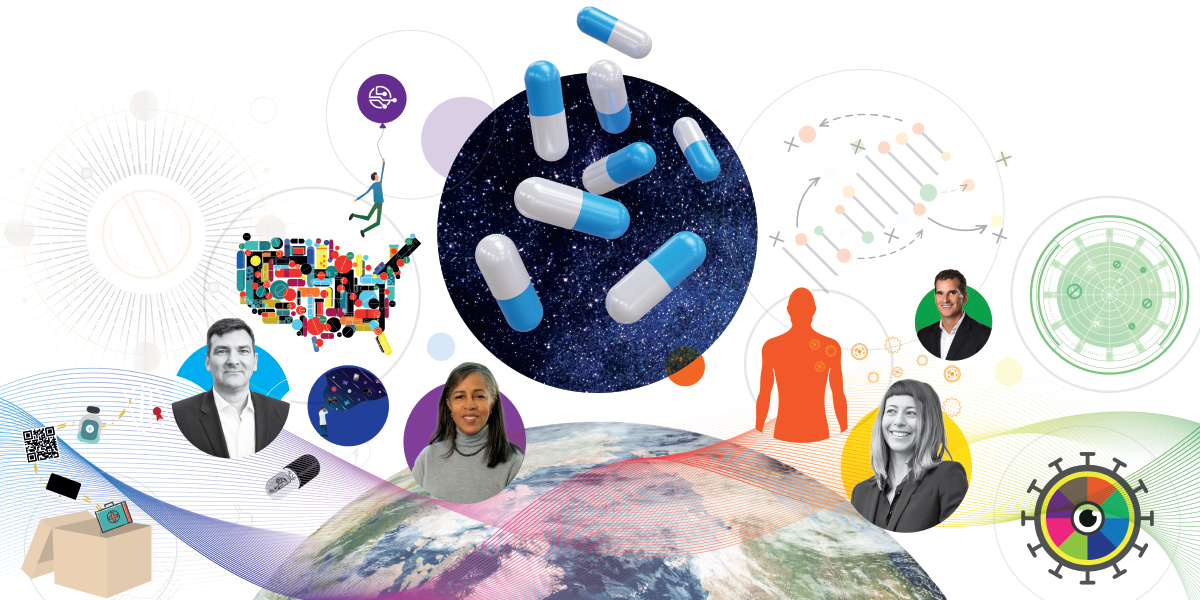The Multifaceted Future of Pharma – Chapter 1: The Big Picture
What will be the key disruptors and/or what can be improved upon in the pharma industry?
What we asked: “Looking ahead to the next 5–10 years, what will be the key disruptors and/or what can be improved upon in the pharma industry?”

“Complex medicines, particularly gene therapies, nucleic acid therapies, and mRNA-based vaccines, have reshaped the landscape. The COVID-19 pandemic was a critical turning point, accelerating the development and approval of mRNA vaccines, which proved to be a powerful tool in responding to global health emergencies. This success sparked tremendous interest in biotech companies and expanded the capabilities of health agencies, leading to more streamlined clinical testing, expansion in contract development and a boom in manufacturing capacity in this area. Looking ahead, we can expect this trend to continue, with even more focus on genomic medicines, particularly gene editing products, as these technologies mature and start becoming approved therapies.
“Digitalization has also revolutionized how the industry operates. Over the past decade, we have seen AI become a cornerstone in drug discovery, helping to identify promising therapeutic candidates much faster. Similarly, modeling and simulation have improved our ability to predict drug performance in humans, while automation is beginning to transform manufacturing processes, ensuring consistent quality and manufacturing efficiency. Remote and virtual disease management has also surged, driven by advancements in mobile technology and accelerated by the pandemic with greater demand for virtual consultations. In the next ten years, these digital innovations will continue to evolve, with AI, automation, and virtual healthcare becoming even more integral to the industry, and making personalized, data-driven care the norm.”

Marcel de Matas
“The pharma and biotech landscape is continually evolving, influenced by innovating technologies, sometimes volatile customer demands, and progressing patient needs. Among the most influential disruptors are digitalization and advanced technology, the rise of homecare medicines, and sustainability efforts.
“Perhaps the most transformative disruptor has been the integration of digitalization and advanced technologies. Robotics, machine learning, and AI have further optimized R&D, manufacturing, secondary packaging, and patient care. Robots receive training from an employee and then carry out the learned steps independently, opening availability for the employee to work on less-routine projects. Having digital software robots perform recurring, clearly definable or time-intensive tasks is thus a modern way of using digitalization to optimize the resources of the employees.
“Another significant driver is the shift towards homecare medicines. Remote care management surged during the pandemic. In this context, patient centricity is becoming a greater priority as many look for homecare solutions that allow for self-administration. The shift from intravenous (administration to subcutaneous) is leading pharma and biotech companies to outsource based on the unique requirements and lifecycles of their molecules. Making drug delivery devices more intuitive and convenient enables more patients to self-treat at home, ultimately saving costs for healthcare systems.
“Despite being a heavily regulated industry on track to sustainable production processes, pharma and biotech still emit high carbon emissions. In response, sustainability has become a priority both for life sciences companies and governments, which are implementing new requirements that businesses need to adhere to. Companies that establish practical green strategies as early as possible will be better positioned to act in a responsible manner in the future to avoid risks such as carbon taxes and to maintain a competitive edge.
“Looking ahead to the next decade, these disruptors will, in my opinion, continue to shape the industry.”

Thomas Otto
“In the last decade, transformative treatments have shown tremendous potential in increasing durability of effect and the hope for a cure in diseases as varied as sickle cell, blindness (an inherited form called Leber’s), spinal muscular atrophy, acute lymphoblastic leukemia, large B cell lymphoma, and hepatitis C. Advancements in gene therapy have been realized through the elucidation of the human genome and with the development of technologies, such as viral and nonviral vectors, to deliver these precious payloads.
“Progress in genomic sequencing technology led to much needed real-time and portable genomic surveillance during outbreaks in regions with limited public health infrastructure, as observed with the Ebola and Zika outbreaks of 2014. Such technology later enabled the industry’s swift response to the COVID-19 pandemic through rapid identification of the SARS CoV-2 pathogen, the development of therapeutics, and mRNA vaccines and public health measures – all in an unprecedented timescale. There are now several mRNA vaccines and RNA-based therapies on the market – as well as in clinical development.
“Whether sequencing organisms, or disease-causing mutations, the availability of genomic information, combined with newer capabilities for nucleic acid synthesis, gene editing, and novel delivery systems have played a key role in the growth of cell and gene therapy. Genetically modified cells for personalized medicine appear more attainable than ever before. As the cell and gene therapy markets grow rapidly, especially for rare diseases with limited treatment options, new companies are emerging, with currently more than 1,000 companies working on advanced therapies globally. These trends are contributing to growing pipelines due to improved processes, resulting in shortened development timelines. On average, drugs designated as Breakthrough Therapies have shorter premarket development and faster approval.
“The cell and gene therapy field is still in its infancy, and the targets thus far have been limited to liquid cancers and orphan diseases. The research has demonstrated the feasibility of these technologies in this area, but the real potential is in solid tumors, chronic diseases and regenerative medicine. To continue uninterrupted, it will be essential to address expectations from regulators in improving manufacturing, containment, and storage standards for all players. In addition to regulatory challenges, access to these potentially transformative treatments is limited due to costs. Solutions such as allogeneic cell therapies versus autologous may mimic a more traditional pharma model, thereby improving scalability – and potentially improving access.
“Additionally, the well established field of biologics – proteins, monoclonal antibodies and vaccines – is advancing rapidly, bringing new treatments and therapies to the forefront of medicine. There are several key emerging trends worth highlighting based on the therapeutic modalities that have become evident over the last decade. With monoclonal antibodies, for example, we see the expansion of product subclasses such as the biologic fusion of antibodies with peptides, proteins, or small molecules (ADCs); radionucleotide ligands, nanobodies; and Fab fragments, all with the hope of improving targeting and increasing efficacy.
“In the protein and peptide therapeutic modalities, we see the use of rational design helping to accelerate the synthesis of novel glucagon-like peptide-1 (GLP-1) agonists, alongside other approaches such as in combination with other molecules for dual and triple combinations for the treatment of diabetes and obesity.
“While it is valuable to look back and celebrate the achievements in our industry’s journey, it is imperative to highlight the anticipated areas where challenges require a call to action, including digital enhancements at home and potential interconnections with data platforms that may improve the patient experience. Such offerings (including large language models and generative AI) come with the promise of opportunities to improve decision making and streamlining care – although they may also be associated with cybersecurity risks and bias. Furthermore, the burden of healthcare is likely to continue to grow as vulnerable populations struggle with increasing chronic disease and the unknown impacts of a digital world. As we move towards solutions that may offer more personalized treatments and therapies, prevention and access should move to the forefront of all our efforts.”

Anya Harry
“The industry has been profoundly influenced by several key disruptors, most notably in the fields of gene-modified cell therapies and in-vivo gene therapies. Gene-modified cell therapies have revolutionized oncology treatment, and the success has spurred significant investments and innovations in life sciences tools that are shifting the focus toward tackling solid tumors. In-vivo gene therapies have similarly made strides, particularly in the treatment of rare diseases. In the next ten years, I also expect to see innovations in drug delivery technologies that enable more precise tissue targeting and lower toxicity. Furthermore, gene editing is poised to enter mainstream treatment for more common diseases, expanding beyond rare conditions.
“There’s also a lot going in manufacturing, particularly for biologics, with significant developments in PAT, continuous manufacturing, and process intensification. These advances are crucial as biologic molecules increase in complexity and cost. In the future, I expect enhanced accessibility and integration of PAT tools becoming standard for large biopharmaceutical entities, CDMOs, and emerging biotech firms.
“Additionally, the evolution of novel modalities such as peptides, protein drugs, and targeted protein degraders, alongside advancements in microsampling and patient-centric sampling (PCS), are reshaping clinical trials. The adoption of PCS, accelerated by the COVID-19 pandemic and supported by analytical technologies, facilitates at-home patient sampling, minimizing patient disruption and allowing for more frequent and accurate data collection. As PCS becomes more widespread, its impact on clinical trial efficiency and the depth of insights into drug effects and human biology is expected to increase significantly since sampling is less restricted and can map environmental changes and other fluctuations.”
“The pharma sector is delivering enormous value to patients through the development of new therapeutics. To continue to ensure and grow that value proposition, it is key to have all involved stakeholders committed to sustainable innovation.
“There are validating and enabling stakeholders. The validating stakeholders are those that sanction the use of innovation as new therapeutic propositions; the enablers are the ones that really invest and take the risk of the new ideas. The investment includes private and public partnerships alongside new business and other models. These are essential for successful translation. Everyone in the industry needs to view this in a global way while aiming for patient benefit. As a result, we must do industrial translation of new therapeutic propositions in a global presence and with local impact.
“Enablers must invest to allow risk taking so that the validators can ensure market access. The way to sustain growth and bring value to patients in need is balanced – but somewhat aggressive – risk taking, always within an ethical context, involving all stakeholders in their respective role. The key driver for the pharma industry is the ability to invest in innovation, science, and talent to develop new value propositions.
“We need strong, committed, bold, and aggressive investment that promotes industrial translation. This investment must be global and the risk taking must be balanced across the different regions to deliver a global solution.”
“The next decade is shaping up to be a period of significant innovation and change, and I think we can look forward to more efficient processes, groundbreaking treatments, and ultimately, better outcomes for patients worldwide.
“Oral solid dose GLP-1 antagonists. I believe there will be technical breakthroughs that will enable these products to be reformulated into oral solid forms. Once brought to fruition, oral formulations of GLP-1s will bring greater patient convenience and compliance. They will also significantly expand market opportunities, and drive growth for CDMOs by increasing demand for specialized manufacturing processes and formulation expertise, ultimately enhancing production efficiency and fostering industry advancements.
“AI. AI could accelerate data analysis, predict molecular interactions, and optimize clinical trial designs. AI has already proven itself in terms of efficiency and quality, and can help better predict how compounds will perform in clinical settings.
“3D printing. With 3D printing, manufacturers can provide an easy, cost-effective method for faster prototyping, personalized dosages, and more complex formulations. This innovation enhances efficiency, reduces waste, and allows for greater customization in pharmaceutical production.
“High potency. Nearly half of all solid dose drugs in development are classified as highly potent. This surge is largely driven by the oncology sector, where many drugs exhibit high potency. In our pipeline, a considerable number of the products we’re developing are cancer treatments. Oncology remains a major focus area for the industry, with almost half of the drugs in development being cancer-related, and 75 percent of those are highly potent. Specialized containment and infrastructure are essential, demanding significant investment to ensure safe and effective handling. Preventing cross-contamination and safeguarding employee health are critical priorities.”

Tom Sellig
“The key disruptor over the past ten years was COVID-19, which I like to refer to as a 'black swan event.' It highlighted the vulnerabilities in the global supply chain, which forced the industry to shift focus towards not just building a partnership, but a long-term relationship. Customers can now see the importance of collaborating with each other and depending on each other – and that is extremely valuable.
“Another big change the industry has seen is the shift away from biologics and cell gene therapy and back to traditional small molecules. When I first founded Adragos, I often got advice to focus on biologics and cell gene therapy to be a leader in the industry. And as a scientist at heart, I stuck to my gut, which told me to stick with small molecules, and I am so happy that I did!
“In the next ten years, I see the industry, along with many other industries, integrating AI and machine learning. These tools can already assist with very specific problems that will have a profound impact on what we do.”

Andreas Raabe
“One of the biggest changes that the industry has witnessed in the past 10 years has been the rise of biological-based drugs and the emergence of new modalities as therapies. With the promise of targeted delivery and improved safety profiles, the rise of biologics was seen to have the potential to replace traditional small-molecule drugs and deliver better outcomes for patients. This drive has been exacerbated by legislative changes in the US, which favors the development of biologics over more conventional therapies, leading to a record year for biologics’ approvals in 2023 – and a record number of large-molecule therapies in drug companies’ pipelines.
“However, with hindsight, it could be questioned whether it is realistic to suggest that biologics are, in reality, ‘replacing’ small-molecules, which have been the mainstay of the pharmaceutical industry for more than a hundred years. Despite the obvious benefits that biologic drugs can bring, the economics of biological manufacturing simply do not add up when compared to small molecules; not just in relation to their manufacturing costs, which are often an order of magnitude greater without a similar elevation in efficacy; but also in relation to the size of the (potential) patient populations and – more importantly – the number of healthcare systems that can actually afford to approve biologics for use.
“Similarly, the protocols of almost all global healthcare systems are predicated on the use of cheaper, small-molecules as first-line therapies. Unless a disease is exceptionally rare and/or no other therapies exist, it is highly unlikely that biologics would be used initially. Other issues with large molecules, such as the challenges of reproducible manufacturing, and the lack of capacity for manufacturing certain classes of biologics are easier to solve, but changing the majority of the world’s healthcare providers’ protocols for their prescription would appear to be a greater challenge for drug companies.
“But perhaps the biggest ‘threats’ to the rise of biologics are not the size of patient populations or their manufacturing cost, but from the continued development of new small-molecule therapies. The increased use of AI in drug discovery is leading to an explosion of new candidates being developed, and advances in manufacturing techniques mean that targets that were once considered either inaccessible – or at least uneconomical to produce at scale – are becoming viable. Similarly, the safety profiles of new small molecule drugs are significantly improved from those developed 20-30 years ago because of a much deeper understanding of the pharmacokinetics, and better manufacturing processes allowing the synthesis of exceptionally pure materials with a very high degree of reproducibility and control.
“Although biologics have the potential to bring significant benefits to patients, the likelihood is that these will be unevenly distributed. Ultimately, despite many opinion pieces over the years claiming the opposite, small molecule therapies will be with us for the foreseeable future, and will almost certainly continue to be used as first-line therapies for the next 10 years. In the vast majority of global medicine, small molecule therapies are likely to be the sole therapy used in a patient’s treatment, with biologics being more a medicine of last resort – and depending upon the nature of healthcare systems and payors.
“So, although I have no doubts that pharmaceutical companies will continue to invest heavily in large molecule research and development over the next 10 years, I would prefer that, rather than eulogizing over the benefits of these therapies, perhaps the focus should be more about developing safe, effective medicines that can be accessed by the widest range of patients and, in the short to medium term, these will likely to be traditional small molecules.”
“Concerns surrounding national security have led to the US instigating the Biosecure Act, soon set to become law, which restricts federally funded drugmakers from doing business with ‘biotechnology companies of concern’.
“Given the drug development industry’s reliance on contract manufacturers, the Act could have far reaching implications for R&D and medicine manufacturing, with the potential to affect more than 120 US biopharmaceutical drugs in development, including those in clinical-stage development and early-stage preclinical trials. It could also lead to a rise in drug prices, with many biopharma companies losing access to low-cost R&D and manufacturing partners.
“In 2019, only around 28 percent of manufacturers producing APIs for the US market were based in the US, where they are unable to offset the labor and other cost advantages provided by contractors in China. Given the current geopolitical situation, pharmaceutical companies are re-evaluating their outsourcing strategy, considering other regions, reshoring, insourcing and strategic alliances. The migration of services from cost-driven companies to specialized CROs/CDMOs in expensive parts of the world will have an overall short term cost impact for the sector.
“The rapid outsourcing landscape changes, along with the associated cost and risks, the post-COVID therapeutic areas readjustment and patent expirations, are forcing key players in the sector to re-size. With ‘do more with less’ becoming the norm, companies are seeking to automate and digitalize to increase efficiency and profitability. Automated, self-driving labs are becoming a must have in drug discovery, with a firm promise to reduce attrition. Those are combined with digitalization platforms, including AI-powered medicinal chemistry and self-describing data assets that expand through the drug life cycle enabling data reutilization across the value chain, not only within a company but also with its ecosystem of partners.
“The use of technology to integrate resources and share knowledge across organizations expedites the scientific discovery process, particularly in finding global solutions to emerging global challenges. Disruptive automation and digitalization systems will empower biopharma to accelerate innovation and reduce time to market through improved collaboration.”

Anna Codina
“Four key objectives should be considered by the international community when it comes to further improving the impact of drug development on global healthcare:
- Secure global protection for innovators. If innovations cannot be reliably protected, it will not be possible to finance the development of a broad range of new drugs, new modalities, and new technologies, given the huge costs and high risk associated with such projects. Patent protection and related market exclusivity are key success factors for any nation that seeks to contribute to the innovation of global healthcare. We have tackled the easier challenges first; the ones that lie ahead will be more demanding, even as we benefit from emerging supporting tools such as AI. Furthermore, our ambition to provide ever more effective, personalized medicine will pose further challenges in financing novel treatment options.
- Harness the power of international collaboration. The smartest minds are not located in any particular country; they are spread across the globe. If we research in silos, specifically constrain access to funding, fail to share discoveries, or isolate parts of the global community, we will inevitably be less successful and slow down progress. At the same time, we will limit the number of parties that could share risk, engage, and contribute to joint efforts to improve health.
- Focus on accessibility as much as on efficacy. Developing an innovative drug that is only available to a few may represent a scientific breakthrough and an important first step, but it is not yet a true innovation because its impact and availability are limited. Innovations that reduce the cost of the discovery, development, manufacturing, storage, or distribution of novel medicines could be more significant than the original discovery if they help to secure access for all patients.
- Involve healthy people in research. The more people learn about how they can delay onset or progression of a disease, the better. If healthy people also recognize that providing their healthcare data helps researchers to improve their understanding of how healthy people differ from those with a disease, they will understand that everyone can make an important contribution to scientific progress. By basing research on a rich set of real-world data, we can accelerate the discovery of new tools, and the active involvement of the healthy population can further improve the public's understanding of why pharma R&D is so valuable.”

Michael Altorfer
"The future offers incredible opportunities for improved patient outcomes as a result of digitalization and AI. We are already seeing the impact on drug development and manufacturing processes that prioritize patient needs, improve accessibility, and drive greater innovation, with even more on the horizon.
“First, I believe we will see a continued shift towards more personalized and targeted therapies, where drug development is tailored to the unique genetic profiles and medical histories of individual patients. This would not only enhance the effectiveness of treatments but also minimize the risk of adverse reactions.
“Second, I expect evolving manufacturing techniques will enhance the scalability, efficiency, and affordability of drug production. Trends to look for include the adoption of continuous manufacturing processes, the utilization of advanced automation and robotics, and the exploration of novel materials and production methods. By reducing the costs associated with drug manufacturing, these innovations would ultimately contribute to greater accessibility and affordability for patients in need.
“Finally, I see a meaningful increase in solutions supporting sustainability and environmental responsibility within the biopharmaceutical industry. This could manifest in the development of greener, more eco-friendly production processes, the implementation of circular economy principles, and the exploration of alternative energy sources to power drug manufacturing facilities. By embracing sustainable practices, the industry can minimize its environmental impact and contribute to a healthier, more sustainable future.
I am optimistic that the next decade will see real, transformative changes driving better outcomes for patients. Drug development and manufacturing can play a meaningful role, ultimately enhancing the overall well-being of individuals and communities worldwide."

David McErlane
The biopharmaceutical industry has experienced significant disruption, driven primarily by advancements in biologics, vaccines, cell and gene therapy, and nucleic acid-based treatments. These modalities have changed the landscape of medicine and offered treatments for previously incurable conditions.
Looking ahead to the next decade, I believe the industry will continue to evolve at a rapid pace. The key drivers of change will likely include further advancements in digital and automated manufacturing technologies including the integration of digital twins. These technologies will enable more efficient, scalable, and flexible production processes, ensuring that complex therapies can be made more quickly and safely.
This growth in digital and automated technologies can also be observed in the modalities themselves. For instance, in biologics the use of computer-based modeling and cell-free technologies is accelerating molecular development and driving faster timelines to the clinic. The innovations in high-density perfusion and continuous manufacturing processes have and will continue to rapidly transform production, again enhancing efficiency and consistency while reducing costs. Another notable example is in automating, closing, and shortening of cell therapy processes to further enhance scalability and reduce CoGS. In gene therapy, we are seeing significant improvement in titer and yield to bring therapy prices down from millions to tens of thousands of dollars.
Furthermore, the collaborative ecosystem among biotech companies, academia, government, and NGOs will be pivotal in driving innovation and accelerating the development of new treatments. By fostering these partnerships, we can meet the growing global demand for advanced therapies and ensure that innovative treatments are accessible to patients worldwide.
The COVID-19 pandemic placed immense pressure on global healthcare budgets because of the urgent need to prioritize vaccine rollouts over regular operations. It also highlighted the need for a revised regulatory framework, where drugs can be approved faster. The idea that it takes ten years to secure FDA approval has been clearly challenged and we are witnessing a shorter time frame between preclinical research and early-stage clinical trials, partly as a direct result of the pandemic's impact.
So, what does this mean for the future of the pharma industry and how are the next 10 years likely to look? The current market will likely be guided by current health priorities, such as patient-focused medicine, development of biosimilars (particularly for oncology and immunology) and generics to drive down costs), along with pushing innovation in the digital space with AI-driven campaigns. What will be interesting to watch is whether the accelerated approval of drugs becomes a new normal or if we return to pre-pandemic timelines.
The next decade in drug development and manufacturing will be transformative, with several key changes expected to revolutionize the industry. Among these, advancing targeted therapies and committing to sustainability stand out as pivotal areas of focus.
The R&D and manufacturing of personalized and targeted therapies will influence the future of medicine. These treatments, designed to target specific genetic or molecular profiles, are expected to be often more effective and have fewer side effects than traditional approaches. The ongoing R&D in targeted therapies will enable the industry to offer more precise and individualized treatment options, improving outcomes for patients with various conditions such as cancer, autoimmune disorders, and genetic diseases.
The pharma and biotech industry is increasingly recognizing the responsibility towards sustainability. Over the next decade, we aim to see a stronger commitment to sustainable practices, not only for the benefit of our industry but also for future generations. This entails reducing the environmental impact of drug manufacturing processes, embracing renewable energy sources, and implementing eco-friendly practices throughout the supply chain.
“In the next 10 years, I would like to see life-saving drugs delivered to the market faster and cheaper than ever before. While we have made many advancements globally towards achieving this goal, the two biggest opportunities that I believe will result in the greatest impact are in the areas of collaboration and innovation. This would start with greater collaboration across governments around the world, at all levels, and extend to life sciences organizations, their leaders, and across the entire supply chain – from raw material suppliers through equipment vendors, design partners, contractors, and distribution. This would also include a significant focus on technology and innovation. We will continue to see tremendous advancements in generative AI, smart factories, end-to-end visibility, and transparency. This is an extremely complex undertaking involving many different stakeholders, but I believe with greater collaboration and continuous innovation, we will drive better outcomes for delivering lifesaving drugs to market faster and more cost-effectively.
“To help achieve such lofty goals, industry organizations and nonprofits that provide a platform to share best practices in manufacturing help bring together leaders to enable collaboration between companies. Whether sharing insights and knowledge on the latest technologies or forming communities of practice to address common challenges in the industry, companies will need to learn from each other to implement new strategies effectively.”